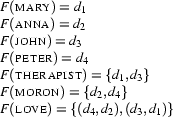5.1.2 An Example Model
Let's look at an example. First, here's our vocabulary from * again:
We will now build a model for this vocabulary. Let  be
be  . This set, consisting of four items, is the domain of our little model.
. This set, consisting of four items, is the domain of our little model.
Next, we must specify an interpretation function  . Here's one possibility:
. Here's one possibility:
Note that every symbol in the vocabulary neatly corresponds to an appropriate semantic entity:
The four names correspond to individuals.
The two arity-1 symbols correspond to subsets of
 (that is, properties, or 1-place relations on
(that is, properties, or 1-place relations on  ).
).The arity-2 symbol corresponds to a 2-place relation on
 .
.
Intuitively, in this model  is called Mary,
is called Mary,  is called Anna,
is called Anna,  is called John and
is called John and  is called Peter. Both Anna and Peter are morons, while both John and Mary are therapists. Peter loves Anna and John loves Mary. But for example we also know that sadly, Anna does not love Peter and Mary does not love John.
is called Peter. Both Anna and Peter are morons, while both John and Mary are therapists. Peter loves Anna and John loves Mary. But for example we also know that sadly, Anna does not love Peter and Mary does not love John.
Given a model of appropriate vocabulary, a formula such as  is either true or false in that model. To put it more formally, there is a relation called truth which holds, or does not hold, between sentences (i.e. formulas without free variables, see Section 1.2.4) and models of the same vocabulary. Now, how to verify if a given sentence is true in a given model is obvious in most cases (for example, in order to check the truth of
is either true or false in that model. To put it more formally, there is a relation called truth which holds, or does not hold, between sentences (i.e. formulas without free variables, see Section 1.2.4) and models of the same vocabulary. Now, how to verify if a given sentence is true in a given model is obvious in most cases (for example, in order to check the truth of  we simply need to check if every individual in the model is a moron). What is not so clear is how to give a precise definition of this relation for arbitrary sentences. This is going to be the problem that the rest of this section deals with.
we simply need to check if every individual in the model is a moron). What is not so clear is how to give a precise definition of this relation for arbitrary sentences. This is going to be the problem that the rest of this section deals with.

